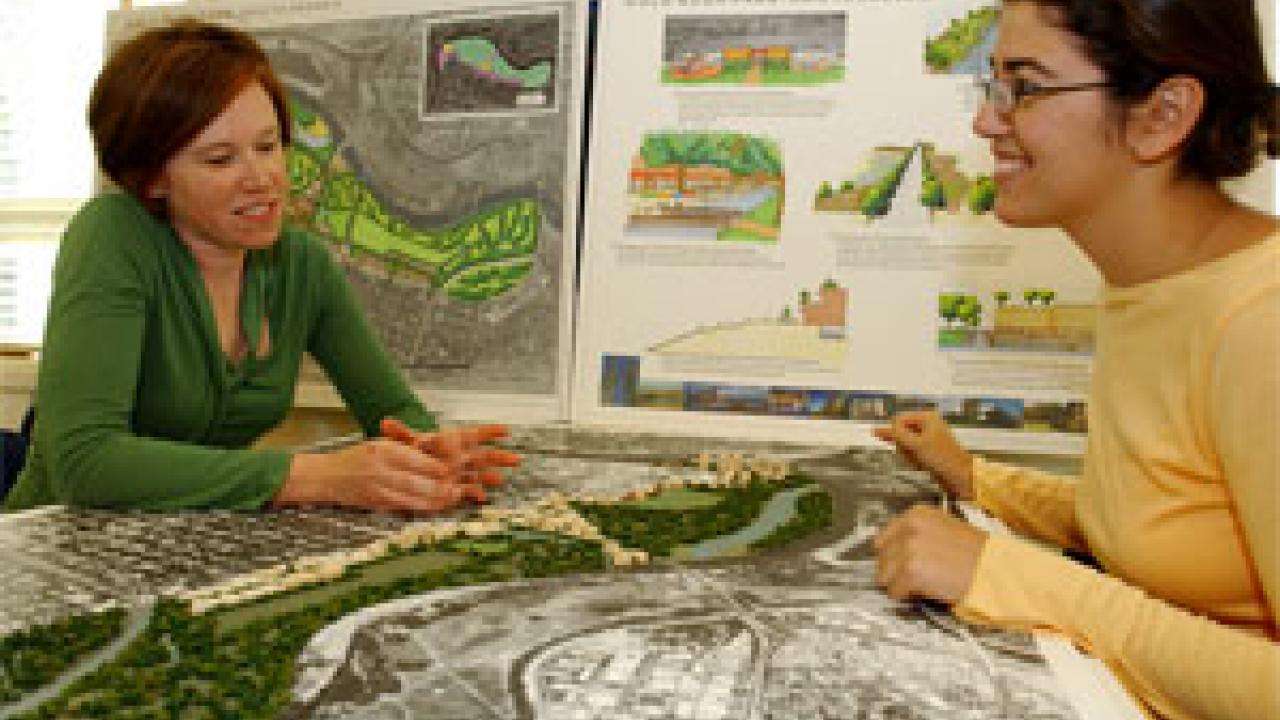For a landscape architect, it is the opportunity of a lifetime: Design an immense urban park on the scale of Golden Gate Park in San Francisco or Central Park in New York City, replacing old warehouses and dilapidated motels with green space, a performing arts center, zoo, riverfront beaches, and mixed-use neighborhoods that sprout high-end townhouses and affordable apartments.
It is "Gold Rush Park," proposed for more than 1,000 acres in Sacramento at the confluence of the Sacramento and American rivers – at the heart of the capital of the most innovative and imitated state in the nation.
And it made an insomniac of UC Davis landscape architecture professor Mark Francis, because the Gold Rush Park Foundation Board asked him and his undergraduate students to translate the board's vision into a coherent design.
Francis has designed many urban parks. He is the landscape architect of Davis' Central Park and Farmer's Market, Davis Commons and the Virginia Fairbanks Art and Nature Park in Indianapolis, among others. But he had never asked juniors and seniors to cram into a 10-week quarter the work that a professional office would do in 10 months.
"I was nervous about taking on this project," Francis said in his campus design studio, surrounded by his students' colorful, detailed posters and scale models of their versions of Gold Rush Park. "I've laid awake nights over this one." With good reason: At the quarter's end, the students were expected to present their designs to the park foundation board, including many of Sacramento's most powerful civic and business leaders.
He was emphatic about the enormity of the task. "The big vision here is to change Sacramento from a go-through place to a go-to place — to establish the green heart that great American cities have that Sacramento has never had."
As envisioned, Gold Rush Park would be the fourth largest park in the United States and more than 200 acres bigger than New York's Central Park. "It will be the biggest project in Sacramento since the building of the State Capitol, six times the size of Land Park and 25 times the size of Old Sacramento." Francis said. "And they came to us."
Actually, they came to Francis and asked him to design the park. It is too soon for that, Francis told them — you need public support for the idea first. But making a number of conceptual designs would be appropriate now, and a great student project.
So his winter-quarter Urban and Community Design Studio class divided into five teams of three or four students each. First they made case studies of other large urban parks, from Germany and Paris to Vancouver and San Diego, and described the history, design style, features, limitations and likely future of each. Then they analyzed the Sacramento park site, which is bounded on the north and west by the rivers and extends east to Cal Expo and south to downtown.
The analysis cataloged all the existing uses and structures in the Richards Boulevard area. It identified historical structures that could be preserved and new, mixed-use structures that might be built in and around the park. (Because the foundation hopes to build the park without taxpayer funds, some new development had to be included to pay for land acquisition and park construction.)
Lastly they prepared their designs for the new park. All featured an urban green for concerts that could hold a million people, an urban village along the 12th Street and 16th Street corridor, major high-rise housing and hotels facing the park and along the Sacramento River, an arboretum, a zoo larger than San Diego's, urban campgrounds and a permanent farmers' market. Transportation elements included miles of pedestrian and bicycle paths, light-rail stations, low-water bridges to connect the north and south sides of the American River Parkway, and water-taxi services to connect Old Sacramento and Cal Expo with the new park.
The students' grades were based on the quality of each analysis, design and presentation but the real "final exam" was making the presentations of their designs to the Gold Rush Park Foundation board and major donors. On the evening of March 16 the class assembled at the downtown offices of a law firm whose 11th-floor windows looked out on the very landscape the students had been reinventing.
They presented their ideas to an audience of about 70, including Joe Genshlea, an attorney who is chair of the foundation board and grew up in Sacramento; Jack Diepenbrock, who is board vice chair and is regarded as the senior land-use law attorney in California; and Robert Waste, board president and a California State University, Sacramento professor of public policy and administration who earned his Ph.D. in political science at UC Davis in 1981.
The park foundation board was very impressed. "It was an overwhelming experience. I couldn't believe even a graduate-level class could do that much work in one quarter. Mark and his class are terrific," said Waste.
Finally, Francis could relax. "The students really rose to the occasion and made us proud," he said, noting that the undergraduates' "extraordinary" work was an act of public service: Done by a professional consultant, it would have cost the park foundation more than $100,000.
In a year or so, Mark Francis is looking forward to helping the board develop the final design for the park. For now, as he sits in his design studio and appraises yet again his students' fresh, creative ideas for Sacramento's future front yard, clearly he is still thrilled by the Gold Rush Park concept.
"Beaches," he mused. "Thousands of people playing on sand beaches in downtown Sacramento. Think about that."
For more information, see the landscape architecture site at: http://lda.ucdavis.edu, or the Gold Rush Park Foundation site at http://www.goldrushpark.org/.
